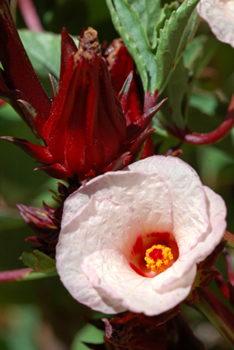Hibiscus Hibiscus sabdariffa

hibiscus tea
- Common Names
- Hibiscus , Roselle, rosemallow, Jamaica Sorrel, red sorrel, agua de Jamaica
- Botanical Name
- Hibiscus sabdariffa
- Family
- MALVACEAE
Medicinal Uses & Benefits of Hibiscus
![]() How to Use|
Side Effects |
Plant & Garden|
Folklore
How to Use|
Side Effects |
Plant & Garden|
Folklore
- Medicinal Uses: * Diet/weight Loss
* Herbal Teas
* Hypertension
* Longevity Tonics
* Nutrition
- Properties: * Antibacterial * Appetite Depressant * Astringent * Cholagogue * Digestive * Diuretic * Emmenagogue * Refrigerant
- Parts Used: flower, Calyx
- Constituents: plant acids including: allohydroxycitric-acid (hca), citric-acid, malic-acid, ascorbic-acid, hibiscus-acid- mucilage, pectin, anthocyanins, calcium, carbohydrates, chromium
How to Use: Hibiscus
Gardeners have always valued the hibiscus is for it's beautiful flowers, but the plant has a very practical side as well. Traditional cultures world wide, from China to the Americas use hibiscus for medicinal teas and natural red dye. In Jamaica it is known as sorrel, in Mexico agua de jamaica. The calyx of the hibiscus flowers is used to make a wine red tea that is naturally high in Vitamin C, a natural antioxidant, and gentle diuretic and laxative.
There are two good reasons to add hibiscus herbal tea to your daily routine beyond the great taste, regular consumption of hibiscus can lower blood pressure and help you shed a few pounds. Drinking hibiscus tea lowered blood pressure in a group of pre-hypertensive and mildly hypertensive adults, according to a study by the USDA.95 Hibiscus is a natural source of hydroxycitric acid (HCA, or hydroxycut), the same chemical used in many diet formulas. It also contains other obesity fighting chemicals such as chromium and ascorbic acid.
Preparation Methods & Dosage :The calyx portion of the flower is dried and prepared as a tea.
Hibiscus Remedies
Hibiscus Side Effects: None noted.
Plant Description

Hibiscus sabdariffa
- Flowers: Large, trumpet-shaped, with five or more petals, ranging from white to pink, red, purple or yellow, and from 4-15 cm broad.
- Plant Class:Flowering plant
- Leaves:
- Fruit:
- Preferred Habitat:Grown as an ornamental, and/or medicinal tea plant
- Flowering Season:
- Distribution: Temperate and Tropical regions worldwide
How to Grow Hibiscus
Hibiscus is both decorative and useful to grow, but requires a tropical environment to thrive. Hibiscus sabdariffa is the species you want to grow if you plan on making tea. It is a shrubby perennial, with pale yellow or pink flowers. It is the bright red calyx that is used for tea, not the flower petals.
History and Traditions & Folklore
The Hibiscus is used as an offering to Goddess Kali and Lord Ganesha in Hindu worship.
-
95. USCA. "Study Shows Consuming Hibiscus Tea Lowers Blood Pressure"
(November 10, 2008),











